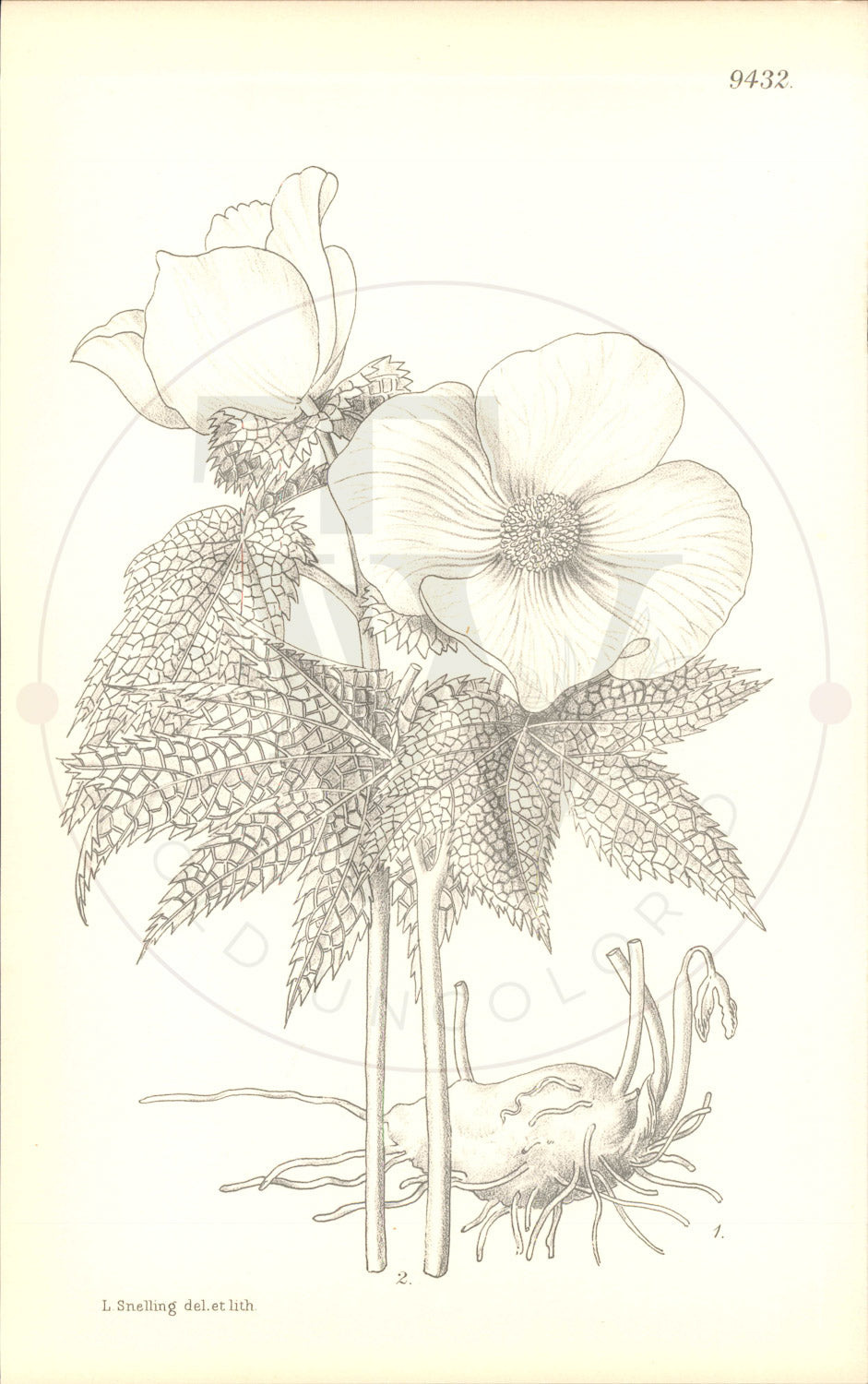Curtis Botanical Magazine
Plate 9432 - Glaucidium palmatum
Plate 9432 - Glaucidium palmatum
Couldn't load pickup availability
Curtis's Botanical Magazine - Plate 9432
Glaucidium palmatum
Native Region: Japan • Publication Date: January 1st, 1934
Distribution: Endemic in Japan, from central Hondo • Tab Author: H. K. AIRY SHAW
Botanical Description
An albino form was described as var. leucanthum by Makino (in Bot. Mag. Tokyo, XXIV. 16: 1910). It is only within recent years that this plant has come into cultivation in British gardens, and it is still by no means common. So far it has been used mostly as an alpine house plant, being usually grown in cold frames and brought into the alpine house in early spring for the beauty of its decorative young foliage and flowers. As stock becomes more plentiful, however, there seems no reason why the plant should not succeed out of doors in cool situations. A north-western slope in the rock garden and a well drained peaty compost, such as is favoured by many choice Japanese plants, should provide the most favourable conditions for its culture out of doors. For the specimen figured we are indebted to Col. C. H. Grey, Hocker Edge Gardens, Cranbrook, Kent. DESCRIPTION. A perennial geophilous herb. Rhizome horizontal, short, thick, irregularly subcylindrical, up to about 2 cm. in diameter. Scale-leaves (bud-scales) 2-4, broadly oblong-ovate, 1-3 cm. long, brown, membranous, glabrous, embracing the base of the stem. Stems solitary, or sometimes two together, 10-40 cm. high, up to 8 mm. thick at base, simple, terete, minutely puberulous, eventually glabrescent above. Foliage-leaves usually 2, in well-grown specimens 3 according to Kumazawa, borne on the uppermost quarter or third of the stem, reniform in general outline, 10-30 cm. or more wide and about four-fifths as long, deeply cordate at the base, palmately 5-7-lobed to about the middle, lobes more or less rhomboid-ovate, the 3 middle ones 2-3-fid at the apex, ultimate lobes acutely acuminate, margins sharply incised-serrate, teeth long-cuspidate, upper surface minutely crisped-puberulous on the principal nerves (young leaves sometimes sparsely puberulous between the nerves), otherwise glabrous, lower surface rather densely spreading-puberulous on all the nerves and veinlets, texture thinly membranous; principal nerves palmate from the base, secondary nerves pinnate, all almost straight till near the margin, impressed above, prominent below; lowest petioles (when mature) up to 20 cm. long, uppermost up to 15 cm. long, triangular in cross-section, puberulous when young, later glabrescent. Bract foliaceous, sessile, reniform to suborbicular, cordate, generally unlobed except shallowly towards the base, sharply incised-serrate, indumentum as on the leaves. Flowers solitary, very rarely 2, terminal. Peduncles simple (if 2, both arising from axil of bract), 0-5-5 cm. long, terete, finely striate, puberulous. Sepals 4, petaloid, broadly obovate-rhomboid, 3-5-5 cm. long, 2-4.5 cm. wide, rounded to very shortly broadly and obtusely cuspidate, entire, slightly puberulous outside towards the base, otherwise glabrous, pale mauve. Petals none. Stamens very numerous, 5-10 mm. long, glabrous: filaments filiform, slightly enlarged and abruptly constricted below the anther; anthers oblong-obovate, about 1 mm. long, subacute, bright yellow, thecae dehiscing laterally. Carpels 2, subcylindrical, 5-6 mm. long, about 1 mm. in diameter, shortly united at the base, ascending-suberect, puberulous along dorsal and ventral sutures; stigmata subcapitate-crescentiform. Fruiting carpels laterally com- pressed, subquadrate, united along inner side representing lowest third of ventral suture, remaining two-thirds forming upper and outer sides, which are straight, lower side slightly curved representing dorsal suture, stigma at lower outer angle, up to 5 cm. across from stigma to stigma, up to 2.5 cm. deep, dehiscent the whole way round the three outer sides, margins eventually subrecurved, gaping; valves conspicuously vertically nerved (i.e., parallel to outer and united edges), nerves fine, subparallel but anastomosing. Seeds pendulous in two rows from upper edge of carpels, the members of the two rows strictly alternating but forming a single line, compressed, broadly winged, obovate, about 1.5 cm. long and 1 cm. wide, brown, membranous; funicle about 1 mm. long. DISTRIBUTION.-Endemic in Japan, from central Hondo to Yezo. H. K. AIRY SHAW.
Synonyms
Hydrastis jezo nsis Sieb. ex Miq. in Ann. Mus. Bot. Lugd. Bat. III. 205 (1867)
About This Print
Original black and white uncolored botanical print from Curtis's Botanical Magazine (established 1787). This 9000s series print is from unissued publisher stock, never hand-colored, representing the authentic plate as it appeared in the magazine. Edited by Sir Arthur William Hill for The Royal Horticultural Society, London.
Share



